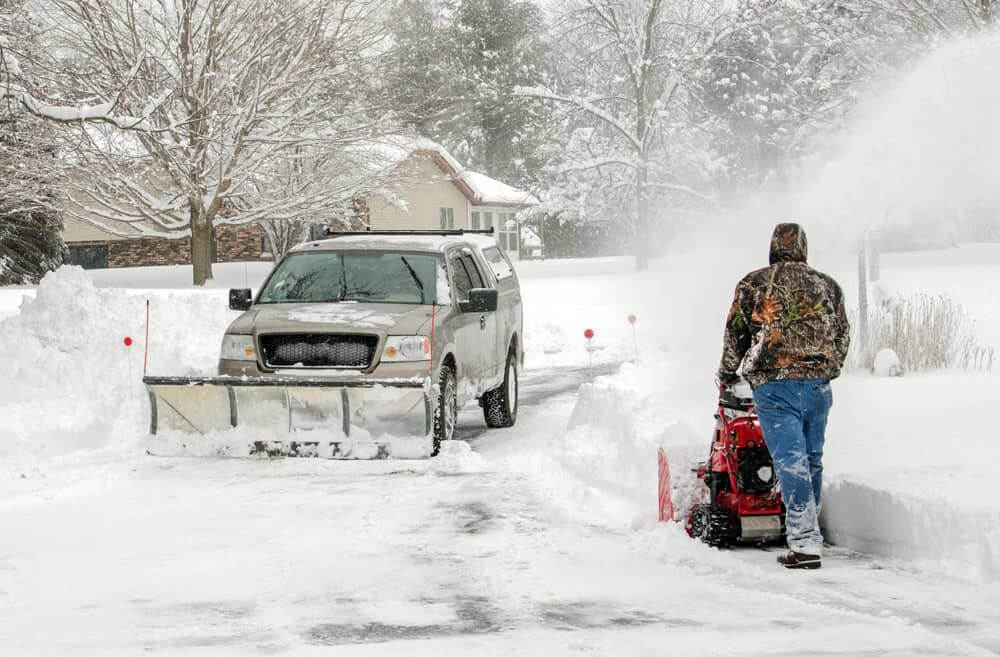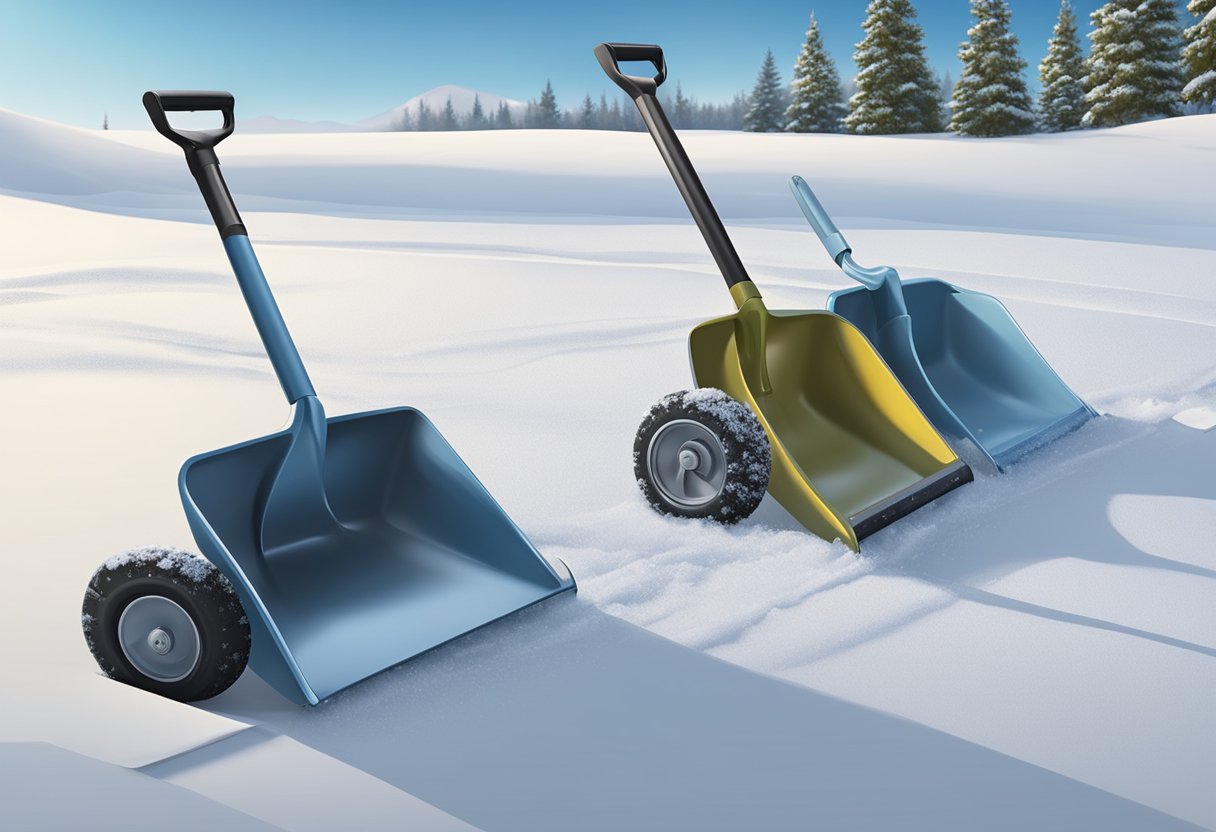Table of Contents
What Is A Snowplow?
Living in a snow belt where heavy snowfalls in the wintertime are the norm brings some challenges for clearing the snow.
You can clear smaller snowfalls or light snowdrifts manually with snow shovels or handheld snow blowers, but heavier falls will need a heavy-duty solution, the snowplow.
Snowplows can be fitted to a vehicle, but how do you choose the right one?
A home snow plow is a snowplow blade that is attached and fitted to standard private cars.
You can then clear snow from your yard, driveway, or access roads without the need to hire a commercial snow plow or blower to move the snow.
Owning your own snowplow for those heavy snowfall months can be a game-changer for keeping access to your home clear from snow and snowmelt.
Unfortunately, snow clearing services can be costly, and the service may not be able to clear the snow according to your needs and timetable.
Purchasing a snow plow for your vehicle should be done with care to ensure effectiveness and prevent damage to your vehicle.
Types of Snow Plows
As you may have expected, snowplows come in various forms and configurations, which poses some challenges for choosing the right snow plow for your needs and vehicle.
The most common types for private vehicles are either front hitch snow plows or rear hitch snow plows.
In addition, snowplows can be fitted to other vehicles such as ATVs, where the choice is usually between a front mount plow and a mid-mount plow under the ATV.
Plows for daily vehicles – Sedans, SUVs, and Trucks.
All snow plows are not suitable for all vehicles, so choosing the right snow plow for your car/truck is crucial, so the plow does not damage your vehicle and gets the job of moving snow done efficiently. How the plow mounts is also an important aspect to consider.
Some plows are mounted in front of your vehicle, pushing the snow directly forward rather than redirecting the snow sideways. A straight mounted snowplow is the best choice for small yards and short driveways.
Larger snowplows mount at an angle to the direction of travel. These snowplows have a longer blade and move large quantities of snow from large areas, long driveways, and access roads.
As you drive, the piled-up snow is directed towards the side of your vehicle rather than straight ahead.
This type of snowplow is perfect for long stretches of snow clearing but normally requires a heavier-duty vehicle than the straight plow.
Front Hitch Snow Plow Pros and Cons
A front hitch snow plow is a plow that fits on the front of a vehicle.
Mounting the plow on the front, you can drive the vehicle forward to move the snow out of the way.
There are several varieties of this plow with different widths, heights, integrated power in the vehicle vs. remote controlled, for different amounts of snow and your needs.
Some plows are shorter than others; the shorter plows are intended for narrow driveways and yards, and they have a smaller scoop that moves smaller depths of snow. Longer plows are for wider driveways, yards, and access roads
Front Hitch Snow Plow Pros
Front hitch snow plows have several advantages that put them in the lead as the top choice for most people.
- It is easier to see what you are doing. For example, driving forward with a snowplow attached to the vehicle’s front is easier in many ways than trying to reverse plow. It is easier to see obstacles in the snow and avoid them, and you don’t have to constantly twist your head around to see where you are going.
- Front hitch plows can be longer. Front-mounted snow plows offer more options from a size point of view, and the number of features included with this type of plow, such as angle adjustability, is greater. In addition, larger plows move more snow, which takes less time to perform the snow clearing chore. This time saving can be substantial depending on the size of the area that needs clearing and the depth of snow.
- Front hitch snowplows are better for long stretches. It isn’t easy to keep your vehicle straight when you are reversing over long distances. If you have a long driveway or an access road that requires snow clearing, a front hitch snow plow is undoubtedly the better choice for this type of job.
- The lights of your vehicle provide job lighting. Driving forward, pushing a snow plow ahead of you gives the added advantage of using your vehicle’s lights to illuminate the area you are plowing. Consequently, there is no need to fit additional lights for snow clearing.
- There is a broader range in selecting front hitch snowplows, from domestic home use varieties for small areas requiring clearing to commercial-grade plows for heavy-duty cleaning.
- Front hitch snowplows are the most common choice for vehicles such as SUVs and trucks, particularly those with 4WD capability. They work the best for clearing large areas, long stretches, and deeper snowfalls.
- Sedans and smaller cars can use front hitch snowplows, but the plow for these vehicles is generally smaller and shorter, limiting the effectiveness for significant snowfalls.
While a front hitch snow plow is the first type of plow that comes to people’s minds when you mention the topic, it may not always be the best choice for your amount of snowfall received or your vehicle type.
Front Hitch Snow Plow Cons
As with most choices, there are some downsides to a front hitch snow plow, which may make this type of snowplow not the right choice for you and your car.
- Weight of the plow. All vehicles have a front gross axle weight rating or FGAWR. The smaller your car, the less weight you can carry on the front axle, limiting the plow you can attach to the vehicle’s front. Remember, the weight you are adding to the axle includes the plow itself, the amount of snow you are pushing, the weight of the people in the car, and any other items you have attached to the vehicle after purchasing it, e.g., a winch.
- You can find the GAWR on the vehicle’s door panel. In addition, the sticker will display the weight limitations for the vehicle. Not following this weight limitation will affect your ability to brake safely and may ruin your front axle.
- Cost of a front hitch plow. Front hitch plows are pricey attachments for your vehicle and are generally more expensive than other snowplows. However, straight front hitch plows usually are cheaper than angled front hitch snow plows. The choice of manual, hydraulic, and electrically adjustable plows also affect the price of the attachment.
- Specialized attachment mounts. Depending on your vehicle, you may need specialized attachments to mount the plow on the front end of your car. The attachment may require a professional to install the fitting, e.g., a front hitch or front mount for a plow or wiring for the hydraulics of the plow, which increases the cost.
- Mounting and removal of a front hitch snowplow. The mechanism to hitch and unhitch the snowplow in front of the vehicle is not as easy as a rear hitch plow. Therefore, before purchasing a front hitch snowplow, consult with the supplier to determine if the snowplow will be compatible with your vehicle. Knowing the maximum load your front axle can carry is a good starting point, but you also need to make sure that the brackets for the plow will be suitable for your vehicle.
Rear Hitch Snow Plow Pros and Cons
A rear hitch snow plow is attached to the vehicle’s rear and functions by driving the vehicle in reverse, pushing snow out of the way.
Some rear hitch snowplows are pull-plows, meaning that you pull them behind the vehicle traveling forward.
However, a pull plow is ineffective since the car has already driven over the snow and has compacted it, making the plow ineffective where the tires have compressed the snow.
A pull plow is also not advised for deep snow since the vehicle would need to drive through the snow before it reaches the plow.
For this reason, we will stick to push rear hitch plows, which function by moving the snow while you drive in reverse gear.
Rear Hitch Snow Plow Pros
Rear hitch snow plows have several features that work in their favor and make them a suitable choice over a front hitch snowplow.
- Rear hitch snowplows are cheaper to purchase than front hitch snow plows. The price difference is because they are usually straight plows only and smaller than most front hitch snowplows.
- A stronger rear axle and suspension. Manufacturers have designed the rear of vehicles to take larger loads, particularly on cars and trucks with a tow hitch. As a result, the rear axle can handle heavier weights than the vehicle’s front axle, which means that you can install a heavier plow on the rear of the car. A heavier plow is more effective at pushing snow. An RGAWR will let you know the weight limit for the rear axle; check your door sticker for this information.
- Reverse gear gives more power and traction. In addition, reverse gear is lower with more torque, allowing the vehicle to better negotiate slippery surfaces or deep snow.
- Easier to hitch and unhitch. Rear hitch snowplows are generally easier to hitch up and unhitch than front hitch plows, mainly plows that fit onto the existing tow hitch on the vehicle. So if your car/truck has a tow hitch, no additional mounting brackets or fixtures are required saving you money on installation fees.
- Better for smaller areas and short driveways. A large front hitch plow may not make sense for small yards and short driveways, but a smaller, more affordable rear hitch plow is perfect for the job.
Rear Hitch Snow Plow Cons
Some of the features that make a rear hitch suitable in some circumstances work against them in other situations.
Let’s examine some of the downsides of these snowplows.
- Reversing is not easy. If you have a large area of snow to clear the snow from, driving for a long time in reverse is not easy, and constantly twisting your head around to look behind the vehicle can become tiresome. In addition, it is a challenge for most of us to keep a vehicle driving straight in reverse down a long driveway.
- Obstacles are not as easy to see. For example, garden faucets, logs, large rocks, small animals, and similar obstacles are not as easy to detect when driving backward.-Rear hitch plows are not as wide. Many rear hitch snowplows are only as wide as the vehicle. As vision and driving backward is not easy, the snowplow being as wide as your car/truck makes it easier for you to control where the plow is going. Some rear hitch snowplow models offer extension wings that extend the width of the plow and provide you more flexibility so you can plow a large area if you are skilled and confident driving backward.
- Insufficient lighting when plowing backward. Front hitch plows have the advantage of the vehicle’s headlights showing the way, but this is not an option when driving in reverse. You may need to invest in rear spotlights to give you sufficient light to plow on dark winter days.
When Would You Use A Snowplow On Your Car?
A snowplow attachment for your car/truck is warranted if you have heavy snowfalls every winter season that makes getting in and out of your property difficult.
I find my driveway a challenge to shovel in the winter as I cannot shovel the snow to the left or right of the driveway as there is a house on one side of it and a fence on the other.
Instead, I shovel the driveway to the front of my home then deposit the snow to the right or left.
Doing this push out of snow becomes heavy and hard to push depending on the depth of the snow.
I have a snow blower, but as the driveway is surrounded on both sides, the snow blower blows the snow forward, and then it piles up, causing a great deal of shovel work once again.
The rear snow plow is ideal for my situation.
I attach the plow to my rear hitch, back out of my garage, push the snow out, and clean up the smaller areas with a shovel.
As the snow melts, it becomes heavier and mushy, turning access roads into muddy car traps that are impassable when the weather warms up and a plow can clear this issue up quickly.
Snow Plow Quick Tips/Secrets
- It is best to plow frequently before the snow piles up too high; otherwise, the snow may be too deep for your snowplow and your vehicle to handle.
- On average, most vehicle-mounted snowplows can handle up to 20-inches of snow quite adequately.
- Depth limitation will vary depending on the type of plow you have and the consistency of the snow, powder, hard pack, or slush.
- The depth of snow you will be moving with the plow depends on the type of domestic vehicle you use to operate the plow. For example, a truck would be able to handle deeper snow better than a sedan.
- When snow falls with a vengeance, many have found that taking shallow cuts off the top of the snow is helpful. Take around six inches at a time rather than trying to push too much snow at once.
- Pushing too large a load of snow can cause problems for your vehicle’s traction and damage the transmission.
- You need to know the area you are plowing to avoid hidden hazards in the snow, which can be anything from tree stumps to boulders, garden faucets, sprinkler systems, or even deep ditches that can cause damage to the plow or your vehicle.
- Having a spotter stand outside while you plow with a rear hitch plow is not a bad idea to ensure your and others’ safety.
- Snowplows are not cheap attachments for your vehicle.
- Rear hitch plows are more affordable, starting anywhere from $300 and going all the way up to $1500.
- Front hitch snow plows generally begin at the $1500 mark and can cost anywhere up to $3000.
- Given the costs, a snowplow attachment for your car is probably only worth it if you have regular heavy snowfalls and the snow clearing services in your area cannot provide an alternative option.
On Which Vehicles Can A Snow Plow Be Used?
Private cars or trucks are not the only vehicles that can attach plow, and in some cases, an alternative vehicle with the plow attached may be the best choice for cleaning the snow from your yard or driveway.
Private vehicles
As discussed with our front and rear hitch snowplows, you can use a truck, an SUV, or even a sedan as a snowplow, as long as the plow you choose is appropriate for the vehicle.
A 4WD vehicle will perform better as a snowplow than a two-wheel drive or front-wheel drive, especially in deep snow, but if you only experience light snow, a sedan may be sufficient.
ATV as a Snow Plow
An ATV makes for a great snow plow, and many manufacturers make plow blades for these vehicles.
The blade is mounted at the front of the ATV or mid-mounted underneath the ATV.
The front mount option is better for larger snowfalls since mid-mount plows are limited to the depth of snow they can push by the ground clearance of the ATV.
An ATV is designed for various types of terrain, making it a better vehicle for driving through deep snow and pushing the snow around, especially if the ATV is 4WD.
Your ATV would need to have at least a 400cc to 700cc motor to work effectively as a snowplow as smaller engines do not have the power or weight to be adequate.
Lawnmower as a snowplow
Ride-on lawnmowers sometimes come with attachments that will convert them into a snowplow.
Generally, these vehicles do not have the power or weight to be effective in this role.
If you only have light snow, they may work for you, but otherwise, you would do better with an ATV or a snowplow for your car.
Robotic snowplows
These are tons of fun to drive from the warmth of your home, but they have limited practicality.
They are pretty small; limiting the amount of snow they can push and therefore increases the time to move the snow.
Robotic snowplows are also significantly more expensive than a snowplow attachment for your car.
Final Plow Secrets
Snowplows on your vehicle can offer convenience when the wintertime comes.
Still, they can also cause significant wear and tear on your vehicle if used incorrectly or the plow is not suitable for your vehicle.
Always get a plow suitable for your type and make of car/truck before committing to a purchase.
Check the specifications for your vehicle and the fitment options for the plow to make sure the two are compatible.
If you do decide to get a snowplow for your car, you will probably be the envy of all your neighbors, and you may even be able to recoup some of your costs for the plow by charging neighbors to clear their driveways!






